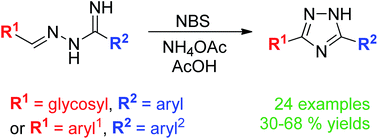Among 1,2,4-triazole derivatives with versatile biological activities 3-C-glucopyranosyl-5-substituted-1,2,4-triazoles belong to the most efficient inhibitors of glycogen phosphorylase, and are thus potential antidiabetic agents. In seeking new synthetic methods for this class of compounds oxidative ring closures of N1-alkylidene carboxamidrazones were studied. O-Peracylated N1-(β-D-glycopyranosylmethylidene)-arenecarboxamidrazones were prepared from the corresponding glycosyl cyanides and amidrazones by Raney-Ni® reduction in the presence of NaH2PO2. Bromination of the so obtained compounds by NBS gave hydrazonoyl bromide type derivatives which were ring closed to 3-C-glycosyl-5-substituted-1,2,4-triazoles in pyridine or by NH4OAc in AcOH. Under the same conditions O-perbenzoylated N1-arylidene-C-(β-D-glucopyranosyl)-formamidrazones gave the expected 1,2,4-triazoles as minor products only. N1-Arylidene-arenecarboxamidrazones were also transformed into 3,5-diaryl-1,2,4-triazoles with NBS/NH4OAc in AcOH indicating high functional group tolerance and general applicability of the method.

